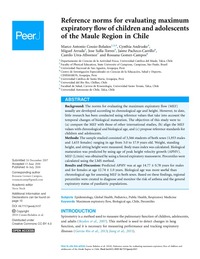Mostrar el registro sencillo de la publicación
Reference norms for evaluating maximum expiratory flow of children and adolescents of the Maule Region in Chile
| dc.contributor.author | Cossio-Bolaños, Marco Antonio | |
| dc.contributor.author | Lee-Andruske, Cynthia | |
| dc.contributor.author | De Arruda, Miguel | |
| dc.contributor.author | Sulla-Torres, José | |
| dc.contributor.author | Pacheco-Carrillo, Jaime | |
| dc.contributor.author | Urra-Albornoz, Camilo | |
| dc.contributor.author | Gómez-Campos, Rossana | |
| dc.date.accessioned | 2018-10-01T12:42:46Z | |
| dc.date.available | 2018-10-01T12:42:46Z | |
| dc.date.issued | 2018 | |
| dc.identifier.uri | http://repositorio.ucm.cl/handle/ucm/1928 | |
| dc.description.abstract | Background: The norms for evaluating the maximum expiratory flow (MEF) usually are developed according to chronological age and height. However, to date, little research has been conducted using reference values that take into account the temporal changes of biological maturation. The objectives of this study were to (a) compare the MEF with those of other international studies, (b) align the MEF values with chronological and biological age, and (c) propose reference standards for children and adolescents. Methods: The sample studied consisted of 3,566 students of both sexes (1,933 males and 1,633 females) ranging in age from 5.0 to 17.9 years old. Weight, standing height, and sitting height were measured. Body mass index was calculated. Biological maturation was predicted by using age of peak height velocity growth (APHV). MEF (L/min) was obtained by using a forced expiratory manoeuvre. Percentiles were calculated using the LMS method. Results and Discussion: Predicted APHV was at age 14.77 ± 0.78 years for males and for females at age 12.74 ± 1.0 years. Biological age was more useful than chronological age for assessing MEF in both sexes. Based on these findings, regional percentiles were created to diagnose and monitor the risk of asthma and the general expiratory status of paediatric populations. | es_CL |
| dc.language.iso | en | es_CL |
| dc.rights | Atribución-NoComercial-SinDerivadas 3.0 Chile | * |
| dc.rights.uri | http://creativecommons.org/licenses/by-nc-nd/3.0/cl/ | * |
| dc.source | PeerJ, 6, e5157 | es_CL |
| dc.subject | Maximum expiratory flow | es_CL |
| dc.subject | Biological age | es_CL |
| dc.subject | Chile | es_CL |
| dc.subject | Percentiles | es_CL |
| dc.title | Reference norms for evaluating maximum expiratory flow of children and adolescents of the Maule Region in Chile | es_CL |
| dc.type | Article | es_CL |
| dc.ucm.facultad | Facultad de Ciencias de la Educación | es_CL |
| dc.ucm.indexacion | Scopus | es_CL |
| dc.ucm.indexacion | Isi | es_CL |
| dc.ucm.doi | doi.org/10.7717/peerj.5157 | es_CL |



